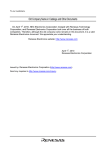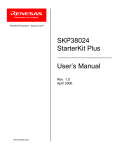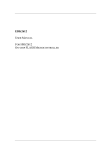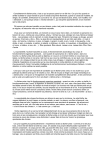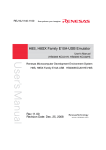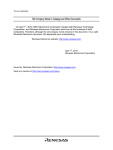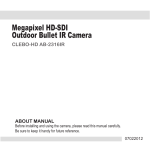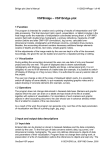Download 3DK2218U USB Kit User`s Manual
Transcript
Applications Engineering 3DK2218U USB Kit User’s Manual Rev. 1.0 August 2007 H8S/2218 USB User’s Manual Preface Cautions 1. This document may be, wholly or partially, subject to change without notice. 2. All rights reserved. No one is permitted to reproduce or duplicate, in any form, a part or this entire document without Renesas Technology Europe Limited’s written permission. Trademarks General All brand or product names used in this manual are trademarks or registered trademarks of their respective companies or organisations. Document Information Date: 08/01/2007 Copyright © Renesas Technology America Ltd. 2007. All rights reserved. Copyright © Renesas Technology Europe Ltd. 2007. All rights reserved. Website:http://www.america.renesas.com/ 3DK2218 USB Kit User’s Manual Page 2 of 12 Aug-07 H8S/2218 USB User’s Manual Table of Contents 1. Power Requirements ................................................................................4 2. Power-up Behaviour .................................................................................4 3. Purpose .....................................................................................................4 4. Board Layout.............................................................................................4 5. Block Diagram...........................................................................................5 6. User Circuitry ............................................................................................5 7. Oscillator Sources ....................................................................................7 8. Modes ........................................................................................................8 9. Programming Methods and 2218UF Kernels..........................................8 10 Headers...................................................................................................10 11 Code Development ................................................................................12 3DK2218 USB Kit User’s Manual Page 3 of 12 Aug-07 H8S/2218 USB User’s Manual 1. Power Requirements All 3DK boards are centre positive with a 2.5mm barrel power jack. The diode, D1 provides reverse polarity protection. A 9V, centre positive supply is suitable for use with this board. Warning Check the silkscreen around the power jack (J9) for the minimum and maximum voltage input levels for this 3DK. The 3DK is neither under nor over voltage protected. Always use a centre positive supply for this board. DO NOT USE AN E6000 POWER SUPPLY with this 3DK 2. Power-up Behaviour The 3DK2218 USB kit has code pre-programmed into the Renesas microcontroller which allows it to enumerate as a Mass Storage Class USB device. On powering up the board, the red user LEDs will start to flash in a sequential manner and upon connecting the USB cable the H8S/2218 enumerates as a mass storage device. 3. Purpose This 3DK2218 USB kit is an evaluation tool for the H8S/2218 Renesas microcontroller and on-chip USB peripheral. Features include: a. Renesas Microcontroller Programming b. User Code Debugging c. User Circuitry such as Switches, LEDs and potentiometer(s) d. User or Base Board Connectivity The 3DK board contains all the circuitry required for microcontroller operation. 4. Board Layout The following diagram shows the component layout top layer component of the board. Note: The diagram below is for illustrative purposes and does not accurately reflect the 3DK detailed in this manual. 3DK2218 USB Kit User’s Manual Page 4 of 12 Aug-07 H8S/2218 USB User’s Manual 5. Block Diagram The following diagram is representative of the 3DK components and their connectivity. 6. User Circuitry 6.1. Switches There are four switches located on the 3DK. These are: Switch Function SW1/Boot This switch is used in conjunction with the RES switch to place the device in BOOT mode. SW2 This switch is connected via a 0R link to an IRQ line capable of waking up the microcontroller device from sleep mode. SW3 This switch is connected via a 0R link to another IRQ line capable of waking up the microcontroller device from sleep mode. RES This switch when pressed resets the 3DK microcontroller. 3DK2218 USB Kit User’s Manual Page 5 of 12 Microcontroller IRQ2 (Pin 97) IRQ4 (Pin 24) IRQ7 (Pin 25) RESn Aug-07 H8S/2218 USB User’s Manual 6.2. LEDs There are nine LEDs on the 3DK board. The green BOOT LED indicates the device is in boot mode when lit. The eight red LEDs are connected to an IO port and will light when their corresponding port pin is set low. Table 6-1 below, shows the LED pin references and their corresponding microcontroller port pin connections. LED Reference (As shown on silkscreen CLED1 CLED2 CLED3 CLED4 CLED5 CLED6 CLED7 CLED8 Microcontroller Port Pin function Microcontroller Pin Number PE0 PE1 PE2 PE3 PE4 PE5 PE6 PE7 Table 6-1: LED Port Pin 64 Pin 65 Pin 66 Pin 67 Pin 68 Pin 69 Pin 70 Pin 71 6.3. Potentiometer A single turn potentiometer is connected to AN0 of the microcontroller. This may be used to vary the input analog voltage value to this pin between AVCC and Ground. 6.4. Serial port The microcontroller programming serial port (SCI2) is connected to the D.type connector J8 via an RS232 transceiver. A secondary microcontroller serial port (SCI2) is connected to generic header, J6 via the second channel of the RS232 transceiver. The serial baud rates supported by this 3DK are shown in table 6-2 below. Note: these values are calculated from the frequency value of the main oscillating source fitted by default on this 3DK. Baud Rate Settings for Serial Communication Rates Values are calculated for 24MHz clock SMR Setting Comm. Baud 110 300 1200 2400 4800 9600 19200 38400 57600 115200 0 BRR setting invalid invalid invalid invalid 155 77 38 19 12 6 Actual Rate invalid invalid invalid invalid 4808 9615 19231 37500 57692 107143 1 ERR (%) invalid invalid invalid invalid 0.16 0.16 0.16 -2.34 0.16 -6.99 BRR setting invalid invalid 155 77 38 19 9 4 2 1 Actual Rate invalid invalid 1202 2404 4808 9375 18750 37500 62500 93750 2 ERR (%) invalid invalid 0.16 0.16 0.16 -2.34 -2.34 -2.34 8.51 -18.62 BRR setting Invalid 155 38 19 9 4 1 0 invalid invalid Actual Rate invalid 300 1202 2344 4688 9375 23438 46875 invalid invalid 3 ERR (%) Invalid 0.16 0.16 -2.34 -2.34 -2.34 22.07 22.07 invalid invalid BRR setting 106 38 9 4 1 0 Invalid Invalid Invalid invalid Table 6-2: BRR Settings 3DK2218 USB Kit User’s Manual Page 6 of 12 Aug-07 Actual Rate 110 300 1172 2344 5859 11719 Invalid Invalid Invalid invalid ERR (%) -0.44 0.16 -2.34 -2.34 22.07 22.07 Invalid Invalid Invalid invalid H8S/2218 USB User’s Manual This serial port may be used as a debugging communication port or as a normal serial communication port when the device is in user mode. 6.5. Jumpers Table 6-3 below describes the function of the 2-Pin jumpers contained on this 3DK board. Reference 2-pin jumper settings Fitted Jumper Function J10 RX Disable PRXD from the RS232 device to U1 is enabled. This enables serial port communication. J11 UVCC power Measurement J14 FWE (Flash Write Enable) J15 EMLE Bypasses R11, a 1206 0R resistor, for current measurement Disables all flash programming, even in BOOT mode Disables the E10A interface. Alternative Disabled. This allows the FDM to program the microcontroller R11 must be fitted to power UVCC Enables Flash programming Enables the E10A interface Table 6-3: 2-pin jumpers Footprint for Jumper only/ Jumper pins fitted Jumper pins fitted (2-way connector) Footprint only Footprint only Jumper pins fitted (2-way connector) 7. Oscillator Sources A crystal is fitted on the 3DK and used to supply the main clock input to the Renesas microcontroller. Table 7-1 details the oscillators that are fitted and alternative footprints provided on this 3DK: Component Resonator Crystal Subclock Footprint Only (4.1mm x 4.7mm) Details 24MHz (recommended) Serial Baud Rate: 115200 Fitted (7.5mm x 5.0mm) 24MHz Serial Baud Rate: 115200 Yes 32.76KHz N\A Table 7-1: Oscillators / Resonators Warning: When replacing the default oscillator with that of another frequency, the FDT programming kernels supplied will need rebuilding. The supplied HMON debugging monitor will not function. The user is responsible for code written to support operating speeds other than the default. See the HMON user manual for details of making the appropriate modifications in the code to accommodate different operating frequencies of the device 3DK2218 USB Kit User’s Manual Page 7 of 12 Aug-07 H8S/2218 USB User’s Manual 8. Modes The 3DK supports User mode and Boot mode. User mode may be used to run, debug and program user code, while Boot mode may only be used to program the Renesas microcontroller with code. To enter boot mode, the mode pins are held in their boot states while reset is pressed and released. The BOOT LED will be illuminated to indicate that the microcontroller is in boot mode. 8.1. Boot Mode The boot mode settings for this 3DK are shown in Table 8-1 below: MD2 1 0 MD1 1 1 MD0 LSI State after Reset End 0 User Mode X (MD0 pin pulled low on 3DK) Boot Mode Table 8-1: Mode pin settings 8.2. User Mode For the device to enter User Mode, reset must be held active while the microcontroller mode pins are held in states specified for User Mode operation. 100K pull up and pull down resistors are used to set the pin states during reset. The H8S/2218U supports single advanced mode, advanced mode with ROM enabled and advanced mode with ROM disabled. 9. Programming Methods and 2218UF Kernels There are two methods of programming. These are boot mode programming and user mode programming. The device must be in the boot mode for boot mode programming and in a user mode (with ROM enabled) for user mode programming. 9.1. Boot Mode Boot mode may be used to program a blank device. Once in boot mode, the boot loader program stored in the microcontroller executes and attempts a connection with a host (for example, a PC). The host, on establishing a connection with the microcontroller, may then transmit program data to the microcontroller via the appropriate programming port. All data in the flash memory will be erased before programming of the device will begin. When in boot mode, the H8S/2218UF device attempts communication with a host via the USB port. The user cannot change this boot programming port to another port. 9.2. User Mode User mode programming is used to program a microcontroller device when the device is in user mode (with ROM enabled). This programming method also allows the user to program the device without first erasing all of its flash memory. To initiate user mode programming, the device must already contain user mode programming code in its Flash memory. In user mode, the user mode programming code stored in the device executes and attempts a connection with a host. The host may then erase some of the device’s memory, perform a blank check, upload data from the device and program the device. The H8S/2218UF user mode kernels are written to establish a connection with a host via the serial port. 9.3. 2218F Kernels and Programming ports The H8S/2218UF kernels are designed to program the device via the USB port when in boot mode, and the serial port when in user programming mode. 3DK2218 USB Kit User’s Manual Page 8 of 12 Aug-07 H8S/2218 USB User’s Manual Table 9-1 below shows the programming port for this Renesas Microcontroller and its associated pins Programming port table – Programming port pins and their 3DK signal names Boot Mode USB D+, pin 32 D-, pin33 programming via the 3DK Signal Name USD_Plus USD_Minus USB port User Mode SCI2 TXD2, pin 100 RXD2, pin 99 SCK2, pin 98 programming via the 3DK Signal Name PTXD PRXD PSCK serial port Table 9-1: Serial Port Boot Channel 9.4. Boot Programming Procedure The microcontroller must enter boot mode for boot programming. The programming port (USB) must be connected to a host for program download. To execute the boot transition, and allow programs to download to the microcontroller, the user must perform the following procedure: 1. 2. 3. 4. Connect a USB cable between the host PC and the 3DK board Depress the RESET switch and keep this held down Depress the BOOT switch once, and release Release the RESET switch 9.5. FDM Header The Renesas FDM (Flash Debug Module) is a USB based programming tool for control and programming of Renesas microcontrollers, available separately from Renesas. The FDM is not supported by this 3DK as this device uses the USB port for boot mode programming. 9.6. E10A Header The Renesas E10A Debugger is a tool for debugging Renesas microcontrollers, available separately from Renesas. The device may be debugged and programmed using the E10A. The E10A utilises H-UDI pins on the H8S/2218U device. To utilise this header the user must make the following changes to the board configuration. 1. Jumper link J15 must be removed 9.7. Off-Board Programming All 3DKs are capable of programming an alternative microcontroller on a secondary board. The user is responsible for providing this second board containing the alternative microcontroller, its supporting circuitry and an FDM or FoUSB header for the microcontroller. To program the alternative microcontroller, the user should perform the following steps • • Connect a cable between the 3DK programming header and that located on the secondary board. Slide switch MCU_SEL to the off-board programming position (OFF). This holds the microcontroller on the 3DK in reset, preventing it from being programmed. 3DK2218 USB Kit User’s Manual Page 9 of 12 Aug-07 H8S/2218 USB User’s Manual 10 Headers 10.1. Micon Headers NOTE: When providing power to the 3DK2218 via a user board, the user MUST remove the regulator (U4). Back-powering of the 3DK2218 board via another board with the regulator in place will damage the 3DK2218 regulator. This does not apply if power is being taken from the 3DK2218 to power a user board. Table 10-1 to Table 10-4 shows the micon headers and their corresponding microcontroller connections. The header pins connect directly to the micon pin unless otherwise stated. J1 Pin Circuit Net Name U1 pin J1 pin number number 1 2 3 4 5 6 7 8 9 10 11 12 13 14 15 16 17 18 19 20 21 22 23 24 Table 10-1: J1 Circuit Net Name U1 pin number 2 4 6 8 10 12 14 16 18 20 22 24 Circuit Net Name U1 pin J2 pin number number 25 2 27 4 29 6 31 8 33 10 35 12 37 14 39 16 41 18 43 20 45 22 47 24 49 26 Table 10-2: J2 Circuit Net Name U1 pin number 26 28 30 32 34 36 38 40 42 44 46 48 50 1 3 5 7 9 11 13 15 17 19 21 23 J2 Pin 1 3 5 7 9 11 13 15 17 19 21 23 25 Board_Vcc NC CON_Vref 3DK2218 USB Kit User’s Manual Page 10 of 12 NC Ground Ground Board_Vcc Aug-07 H8S/2218 USB User’s Manual J3 Pin 1 3 5 7 9 11 13 15 17 19 21 23 J4 Pin Circuit Net Name CON_OSC2 Ground CON_Extal Circuit Net Name 1 3 5 7 9 11 13 15 17 19 21 23 25 3DK2218 USB Kit User’s Manual U1 pin J3 pin number number 51 2 53 4 55 6 57 8 59 10 61 12 63 14 65 16 67 18 69 20 71 22 73 24 Table 10-3: J3 U1 pin J4 pin number number 75 2 77 4 79 6 81 8 83 10 85 12 87 14 89 16 91 18 93 20 95 22 97 24 99 26 Table 10-4: J4 Page 11 of 12 Circuit Net Name CON_OSC1 CON-Xtal Board_Vcc Circuit Net Name Board Vcc Ground U1 pin number 52 54 56 58 60 62 64 66 68 70 72 74 U1 pin number 76 78 80 82 84 86 88 90 92 94 96 98 100 Aug-07 H8S/2218 USB User’s Manual 10.2. Generic Headers Table 10-5 below shows the generic header connections Pin number 1 19 way generic header Generic 3DK signal header name name Supply Supply 2 Xin 3 4 5 6 7 8 9 10 11 12 13 14 15 16 17 18 19 Vcc Vss Vcc Vss AVcc AVss Vref AN0 AN1 AN2 AN3 AN14 AN15 not connected not connected not connected not connected • • 20 way generic header Generic header 3DK signal name name Spare SCI Tx pin IOPORT_TXD RS232 levels CON_Xtal 61* 2 Spare SCI Tx pin IOPORT_RXD RS232 levels Vcc1 N/A 3 TIOCA1 IOPORT_T1 Ground N/A 4 TIOCB1 IOPORT_T2 Vcc2 N/A 5 TIOCA2 IOPORT_T3 Ground N/A 6 TIOCB2 IOPORT_T4 NC N/A 7 IOPORT_U NC Ground N/A 8 IOPORT_V NC CON_Vref 41* 9 IOPORT_W NC Pin 45 (AN0) 45 10 PE0 IOPORT_0 Pin 44 (AN1) 44 11 PE1 IOPORT_1 Pin 43 (AN2) 43 12 PE2 IOPORT_2 Pin 42 (AN3) 42 13 PE3 IOPORT_3 NC N/A 14 PE4 IOPORT_4 NC N/A 15 PE5 IOPORT_5 NC N/A 16 PE6 IOPORT_6 NC N/A 17 PE7 IOPORT_7 NC N/A 18 /Reset RESn NC N/A 19 /NMI IOPORT_INT 20 Vss Ground Table 10-5: Generic Headers Micon pin N/A Pin number 1 Micon pin 22 23 6 7 8 9 N/A N/A N/A 64 65 66 67 68 69 70 71 58 81* N/A Connected via either a 0R link or a DNF 0R link, refer to the schematic for further details. Connected via a transceiver chip 11 Code Development For all code debugging using Renesas software tools, the 3DK2218 board must be connected to a PC via the E10A-USB debugger (not supplied with the USB kit). After installing the tools (Compiler and HEW), copy the included workspaces to C:\Workspace before running them; opening them from any other location will cause a “This workspace has moved…” warning. If you wish to run the workspace from another location select “OK” and continue. 11.1. Additional Information For details on how to use High-performance Embedded Workshop (HEW), refer to the HEW manual available on the CD or from the website. For information about the H8S/2218UF series microcontrollers refer to the H8S/2212, 2218 Series Hardware Manual available on the CD or from the website. For information about the H8S/2218UF assembly language, refer to the H8S Series Programming Manual Further information available for this product can be found on the Renesas web site at: http://www.america.renesas.com/ For technical support/information send an email to [email protected] 3DK2218 USB Kit User’s Manual Page 12 of 12 Aug-07












